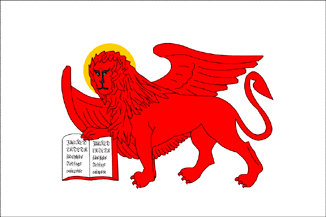 image by Jaume Ollé, 9 November 1998
image by Jaume Ollé, 9 November 1998
FOTW beschńftigt sich mit der Wissenschaft der Vexillologie (Flaggenkunde).
Alle auf dieser Website dargebotenen Abbildungen dienen ausschlie▀lich der Informationsvermittlung im Sinne der Flaggenkunde.
Wir distanziert uns ausdrŘcklich von allen hierauf dargestellten Symbolen verfassungsfeindlicher Organisationen.
Last modified: 2021-08-24 by rob raeside
Keywords: italy | veneto | st. mark | winged lion | serenissima | venice | venezia |
Links: FOTW homepage |
search |
disclaimer and copyright |
write us |
mirrors
See also:
Other Sites:
1) image by Jaume Ollé, 9 November 1998
image by Jaume Ollé, 9 November 1998
2)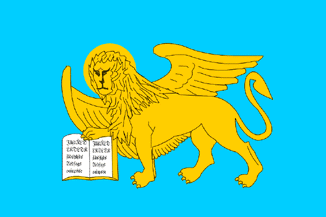 image by Jaume Ollé, 9 November 1998
image by Jaume Ollé, 9 November 1998
The first venetian flag is dated from 1177 and bears several
representations of Saint Marco. In the XIV century the lion
appear (with the face of Saint Marco). It was red on white
background and is quoted also in golden on blue background. I
don't have real images of this flags and I made the
reconstruction in the modern ratio 2:3.
Jaume Ollé, 9 November 1998
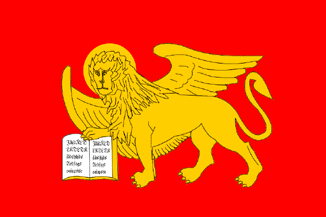 image by Jaume Ollé, 9 November 1998
image by Jaume Ollé, 9 November 1998
In the end of the XIV century the background started to be red
and the lion golden. A variant of this flag is reported with only
half of the lion in the fly (the head and half body)
Jaume Ollé, 9 November 1998
The lion was always complete from the middle of the 14th
century. The republic of Venetia never codified its heraldry, so
there are no official designs for the flags
Mario Fabretto, 8 june 1997
The cover of [sie63] shows what
the book describes as approximately a quarter of a flagchart, one
of many to roll of the, mostly Dutch, presses for the use of
seafarers: "Tableau des Pavillons que la Plupart des Nations
arborent a` la Mer. Faitau de'po^t des cartes et plans de la
marine pour le service des vaisseaux du Roy par ordre de M. de
Machault, Garde de se'aux de France. Par le Sr. Bellin Inge'nieur
de la marine. 1756." [beL56]
On the 4th row from the bottom there is "Pav. de
Venise" - A flag of 3 flywise stripes 7/1/1, red, blue, and
red. On the upper red stripe, based on the blue stripe in gold
the image of a male bearded sfinx looking hoistward, in his right
paw a high latin cross, his left paw resting on an open book of
many pages opened hoistward in gold (which is also based on the
blue stripe), its tail coiling forward, then behind its body,
then between its hind legs then backward.
Peter Hans van den Muijzenberg, 4 January 2001
 image by Jaume Ollé, 9 November 1998
image by Jaume Ollé, 9 November 1998
On 15 May 1797 Venecia was occupied by Napoleon, and on 1 June
a Public Salvation Committee decreed that the lion is suppressed.
Seems that the blue and yellow colors were adopted (those colors
were the favorite of Napoleon or can be taken from the old
shield). They are known cockades with those colors after 9 April
1797. The Republic took the name of Saint Marco and after a small
period was merged with the Italian Republic (later kingdom).
Jaume Ollé, 9 November 1998
According to the Venetian web pages I spoke about for two
days, the Venetian Republic never officialized till 1797 its
heraldic emblems. The same could maybe be said concerning the
flag or the gonfalon of the city.
The Venetian pages say : (I quote and translate)
"At the fall of the Serenissime Republic in 1797, the
provisory Municipality substituted the secular inscription
"Pax tibi Marce evangelista meus" on the book of the
lion with the words "Diritti e doveri dell'uomo e del
cittadino" [Human and citizen rights and duties]."
It doesn't seem that the lion was suppressed at that time.
"With a decree of the Vice-king Eugene Beauharnais of the
18th February 1806, a coat of arms was adopted, showing all the
coats of arms of the states constituting the Italian Kingdom on
the Napoleonic Eagle. With patent letters, a coat of arms was
adopted on the 22nd February 1813 in which the ancient emblem of
Venice doesn't appear".
Pascal Vagnat, 9 November 1998
I believe that the lion follow (1797) in the city flag but is
suppressed in the state flag.
Jaume Ollé, 10 November 1998
I had the chance to get a copy of the "Raccolta di Carte Pubbliche,
Istruzioni, Legislazioni, ... del nuovo Veneto Governo Democratico - Volume
Primo" (Collection of Public Documents, Instructions, Laws ... of the new
Democratic Government of Venice - First Volume), printed in Venice, 1797.
The list starts on May 13, 1797, with the announcement of a provisional
government and the settlement of a limited number of French troops in some fixed
places of the Capital (i.e. Venice).
On May 16, the government announced
the Republic and a change in the words of the open book in the arms: "A cui in
vece dell' antica Iscrizione viene sostituita la seguente : Diritti, e Doveri
dell' Uomo e del Cittadino" (to which, instead of the ancient text, the
following is substituted: Rights and Duties of Man and of the Citizen).
The change is short-lived, as the Lion is replaced by the Liberty badge on May
20, no further details are given.
And the flags? In the whole collection
no flags are mentioned and we may suppose that the French Tricolor was displayed
by the French troops and that was enough. Nonetheless, a decree was issued to
determine the cockade already on May 18: "la Nazione ha adottato tra gli altri
quello della uniforme Coccarda tricolore Verde, Bianco, e Rosso" (the Nation
adopted among the others (symbols) that of the standard Green, White and Red
three-colored cockade).
The documents refer to "La MunicipalitÓ
Provisoria di Venezia" (The Provisional Municipality of Venice), which would
have joined the other towns of the former state in a new republic. On May 27 the
Provisional Municipality of Venice invited the inland Municipalities (of the
former state) to send their representatives to Milan, to agree the capital of
the new republic under the guide of the "General in Capo" (Leading General, i.e.
Napoleon). Please, remove from the page the reference to the Republic of Saint
Marco, which instead applies to the 1848-1849 revolution.
A decree issued
on May 28 is remarkable. It warns the citizens about the incoming visit of the
General and among the instructions we find a very interesting one: "I colori
Italici siano scelti preferibilmente a tutti gli altri, onde far conoscere all'
universo intiero , che entriamo anche noi nello stesso spirito della LibertÓ
Italiana" (The Italian colors shall be preferred to all the others, in order to
let the whole universe to know that we too join the same spirit of the Italian
Liberty). By means of this, we may infer that flags in the Italian colors did
appear during the short life of the Provisional Government of Venice in 1797,
albeit never officially introduced. Venice had to wait till the 1848 to see
those colors flown, by another republic still.
Please, note that all the
Italian text above is written in contemporary language and it matches the
original in the document, including the capital letters. It differs in some
details from the current Italian.
I hope this sheds some light on an
otherwise obscure time of the history of Venice during the Napoleonic wars.
Pier Paolo, 23 August 2019
Venecia was given to Austria in Vienna Congress - 1815
Jaume Ollé, 9 November 1998
"In 1825 the Austrian government conceded a coat of arms
[to the city of Venice] which consisted of the lion of Saint-Mark
in natural colours on a field azure. The coat of arms is
surmounted by a ducal crown..."
Pascal Vagnat, 9 November 1998
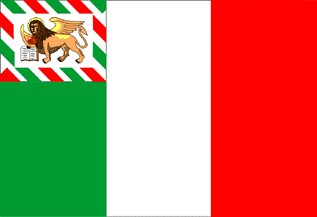 image by Jaume Ollé, 9 November 1998
image by Jaume Ollé, 9 November 1998
In 1848 Venice revolted and the Italian flag was used with the
Venetian lion in the canton. Austrian retook it 1849.
Jaume Ollé, 9 November 1998
"Daniele Manin [I don't know who he is] with a decree of
the 21th March 1848, gave [the city] a flag, tricolore
green-white-red, with a white rectangle bordered with these three
colours and charged with the lion passant or, in the upper third
of the green stripe".
Pascal Vagnat, 9 November 1998
In 1860 Venice was returned to Italy.
Jaume Ollé, 9 November 1998
" The communal council of Venice, in his sitting of the
15th December 1879 adopted as coat of arms a shield azure with
the lion of Saint-Mark or "in moleca" [only the head, a
part of the body and the paws of the lion are to be seen]. (...)
The civic flag was the national tricolour with in the canton a
red rectangle with the lion of Saint Mark passant or, in the
upper third of the green."
Pascal Vagnat, 9 November 1998
 image by Jaume Ollé, 9 November 1998
image by Jaume Ollé, 9 November 1998
the blue line meaning the sea. Seems that was in use until
1942.
Jaume Ollé, 9 November 1998
This flag appears at J.W Norie - J.S. Hobbs Flaggen aller
seefahrenden Nationen, 1971[ nor71]
(original print 1848) as
183 Venice Peace (as Venice War Flag except
the stance of the lion of St. Marcus is less aggressive, the book
is clear and open, and it holds a cross, rather than a sword).
For one thing, its tail apparently curves over its back, behind
its body and between its legs. The field part encircled by the
curve of the tail has apparently been miscoloured as part of its
body.
Peter Hans van den Muijzenberg, 12 November 2001
The part between the tail and body is also yellow in [zna99].
Željko Heimer, 13 November 2001
 image by Jaume Ollé, 9 November 1998
image by Jaume Ollé, 9 November 1998
The city flag was changed 1942 for an pro-Italian design.
Jaume Ollé, 9 November 1998
" With a decree of the Head of the Government of the 1st
of May 1942, [emblems] were conceded to the city of Venice: a
coat of arms [same as the former one, the lion being surmounted
by an aureole (nimbus) holding the open book of the Evangile with
the words in black letters "Pax tibi Marce evangelista
meus". The top of the shield is gules (purple) a bundle of
lictors or .... The shield is of Venetian form, and is surmounted
by a doge crown], a seal, a gonfalon [red semé with stars or,
with the lion of Saint Mark or passant, its dexter upper paw on
the book of Evangile, on the earth from which is issuing a
fortress and its lower paws on water. The gonfalon is bordered
with gold ornament and sacral pictures representing the four
Evangelists, the Annunciation to the Holy Dove. The gonfalon is
ended with seven "tongues" ornamented with symbols of
war.], a flag [vertically green-white-red with a red rectangle
with the lion of Saint-Mark passant or in the green field].
In fact, this flag seems to have been little in use, and the
better know copy of the gonfalon (or its variant) was in use.
Pascal Vagnat, 9 November 1998
Here is another Venice flag. It is from the Times Atlas of
World History. The caption says it shows the "Lion standing
on land as well as on water, symbolising the Republic's dominance
of its hinterland as well as of the Adriatic". The
"flag" actually looks more like a tapestry to me. Can
anybody identify exactly what this flag is?
T.F. Mills, 8 May 1999
On my local copy of the Times Atlas of World History (1993)
there is an image on p. 182, which looks strangely familiar to
the 'flag' you sent. It is a stone relief with this text: 'The
Venetian Republic controlled extensive territories in the eastern
Mediterranean and the Lion of Venice stood guard on coastal
fortresses in Greece and the Balkans, as well as in Crete and
Cyprus. The lion stands on land as well as water, symbolizing the
Republic's dominance of its hinterland as well as the Adriatic.'
The stone relief stands guard on Cyprus.
I am curious: was the stone relief made into a flag? - in which
case it is a Cyprus flag. The structure on the right is in my
edition a round tower with three levels. Can you tell in which
year the Times Atlas you quote was edited?
Jarig Bakker, 9 May 1999
I found out that It is part of a (rather complicated) flag on
p. 141 of FTAAATW. Caption: " Since 1300 the main design of
the Venetian flag has remained the same. .. This design from the
end of the 17th century has the lion partly on land and partly on
water, signifying that the Venetian Empire extended from the
hinterland of the city to the whole Adriatic Sea."
On the same page info on the Venetian flag, which doesn't seem to
be correct: " Gold and red were possible chosen because
these colors had been used by the Byzantine Empire and Venice
claimed that region. The old design of the flag, which at present
is proudly hoisted in front of the San Marco church, has four
rectangular tails..."
The flag on p. 141 has 6 tails, as has the flag in 'Venice' by
John H. Davis, Newsweek, New York, 1979 - (too big ; some
tourists might have noticed that too. Same flag on 'serenissima'
.
So the image sent by Tom is part of a flag; I assume the whole
flag is impossible to become a GIF.
Jarig Bakker, 9 May 1999
IMHO, it is "just" a detail from the flag, and it
really looks like tapestry, as you say - very ornamented. Still
today a similar flag is used by modern city of Venice and Regione
del Veneto. The lion of St. Mark was used as symbol of Venice,
both on flags and as stone relief (functioning as some kind of
COA, I believe). Such reliefs were put in fortification walls,
usually above the gates,
Željko Heimer, 10 May 1999
This image is also to be found on page 112 of "Heraldry:
Sources, Symbols and Meaning", Ottfried Neubecker, 1997,
Tiger Books International (London), where it is referred to as
"Venetian flag from the 17th century; Venice, Museo
Correr".
So it seems it is definitely an actual flag.
Santiago Dotor, 19 May 1999
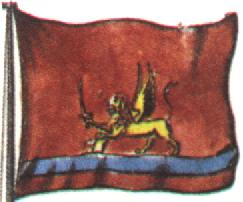 image contributed by Jarig Bakker, 9 March 2001
image contributed by Jarig Bakker, 9 March 2001
Scan from Norris/Hobbs: 'Maritime flags of all nations', 1848
Venice flag in peace time is with the open book, but in war
time it has the sword instead of the book.
Andrea Fassetta, 8 March 2001
Above is a scan from Norris/Hobbs: 'Maritime flags of all
nations', 1848, which is alongside the Venetian Peaceflag.
Jarig Bakker, 9 March 2001
The picture from Norie-Hobbs' book is quite correct, but there
was another difference between both flags: in the war flag the
lion rests with its paw on a closed bible.
Ralf Stelter, 9 March 2001
For some reason, I've always been under the impression that it
was not so much a flag used in time of war as the flag used by
warships, as opposed to merchant ships, possibly because the
carved lions at the Arsenal also have the closed book. Ralf
and Jarig's posts suggest I was mistaken...can anyone confirm the
actual usage?
The reason the book (actually not a Bible) is closed is that the
text is "Pax tibi Marce evangelista meus" ("Peace
unto thee, Mark, my evangelist"), a sentiment not deemed
appropriate for military activities.
Joe McMillan, 9 March 2001
I used the term "war flag" as this is the old German
term for naval ensign. I also have had the impression that both
flags were naval flags and no "war time" and
"peace time".
Neubecker in "Fahnen und Flaggen", c. 1939, writes that
merchant ships had the flag with cross, war ships the flag with
sword. He also shows the book opened in the war flag. And all
other illustrations also show the sword in combination with an
open book. I have only one note in my files with sketches of both
flags where on the "war flag" the book is closed, but
to my shame I can not find the source. What I found: Aldo
Ziggioto quoted in his vexilla Italica series about flags of the
italian states the "Dizionario Historico Tecnico Pratico
della Marina", edited in 1759 in Venice, which writes about
naval flags: "the lion presents either the cross or the
sword, but only the cross on merchant flags". So maybe that
warships used either of the flag depending of the state they were
in (peacetime - wartime), but that is not certain...
But what book is it, when it's not a bible? I know that in the
beginning it was a roll of parchment, later it was a book, and I
got the impression it was a bible, although it is not mentioned
as such in any source.
Ralf Stelter, 9 March 2001
The quotation is not biblical. It is from a mediaeval
legend that an angel appeared to St. Mark when he was traveling
from Aquileia (at the head of the Adriatic) to Rome and said to
him "Pax tibi, Marce, evangelista meus. Hic requiescet
corpus tuum," (Peace unto thee Mark my evangelist.
Here your body will rest.) Since the text is not biblical,
I conclude that the book cannot be a bible.
Joe McMillan, 9 March 2001
This flag appears at J.W Norie - J.S. Hobbs Flaggen aller
seefahrenden Nationen, 1971[ nor71]
(original print 1848) as
182 Venice War.
What isn't as clear from the scan is that part of the book is
coloured red. At first this looks like an attempt to erase half
the book, as a last minute correction to conform with the War
Ensign having a closed book. But if examined more carefully, a
tiny black line can be seen, which would suggest that indeed a
part of the page was to be coloured red. Apparently, the book is
torn, or blood was spilt.
Peter Hans van den Muijzenberg, 12 November 2001
Comapre notes by Ralf Stelter. I would be ready to agree with
him, that there is no war-time and peace-time flag variants, only
the merchant and naval version, the only (meaningful, certainly
though history many variations were made) difference is what the
lion holds - either sword or cross, the first being used on naval
vessels and latter on merchant. Also, at the time it may not be
quite clear what Venetian ships are of what category - they
would be similarly built and equipped...
Saying that, I believe that there is no such thing as closed book
being naval variant - it must be one of those "urban
legends" and nothing more.
Regarding the "blood" on the book, IMHO, it is nothing
more then some point from the flag field entering the area that
should be coloured yellow - a number of similar
"peninsulas" could be find in other flags, too. There
is no significance it it.
Željko Heimer, 13 November 2001
Actually, this is the point where I disagree with Ralf: Ships
changed function in times of war. Eg. a merchant would maybe be
employed as transport ship. So judged from the viewpoint of that
ship, the flags could well be War and Peace. Whether this use was
institutionalized, and/or whether the distinction of a Naval Ensign
was, would at the very least depend on the time these flags were
flown.
I know for certain that there is such an variant, now. I've just
been given a catalogue of Adria Bandiere, where all three
Venetian banners they picture/offer/produce have St. Marcus
holding the book in his right claw, the left is simply supporting
him. (This is much easier on the book than those historical
versions were, if they existed.) However, they also have a jack,
quartered, with in one of the quarters St. Markus holding the
Sword, and with his left paw standing n the closed book lying on
the ground!
Peter Hans van den Muijzenberg, 15 November 2001
 image by Eugene Ipavec, 16 March 2010
image by Eugene Ipavec, 16 March 2010
The 32th flag mentioned and illustrated in the Book of All
Kingdoms [f0fXX] is attributed to
Venice. This as depicted in the 2005 spanish illustrated
transcription [f0f05], a white
flag with the winged lion of St. Mark in red, facing the hoist,
nimbused in white and holding/reading a white paper roll (not
book); the flag shown in the ogival default shape of this source.
The anonymous author of [f0fXX]
describes the flag thusly: "El se├▒or d’esta Venecia ├í
por se├▒ales un pendon blanco con un le├│n bermejo con alas,
commo el evangelista san Marcos." (The lord of this Venice
has for sign a white pendon with a red lion with wings, like Mark
the Evangelist).
António Martins-Tuválkin, 17 November 2007
 image by Jaume Ollé, 13 February 2003
image by Jaume Ollé, 13 February 2003
No. 229 - Venice (several variants)
Source: [stb62]
Jaume Ollé, 13 February 2003
 image by Jaume Ollé, 13 February 2003
image by Jaume Ollé, 13 February 2003
No. 230 - Venice (several variants)
Source: [stb62]
Jaume Ollé, 13 February 2003
Hosted by: Fanshop-Online.de und Handy-Shop.de
Tipp: Apple iPhone 12 im Shop